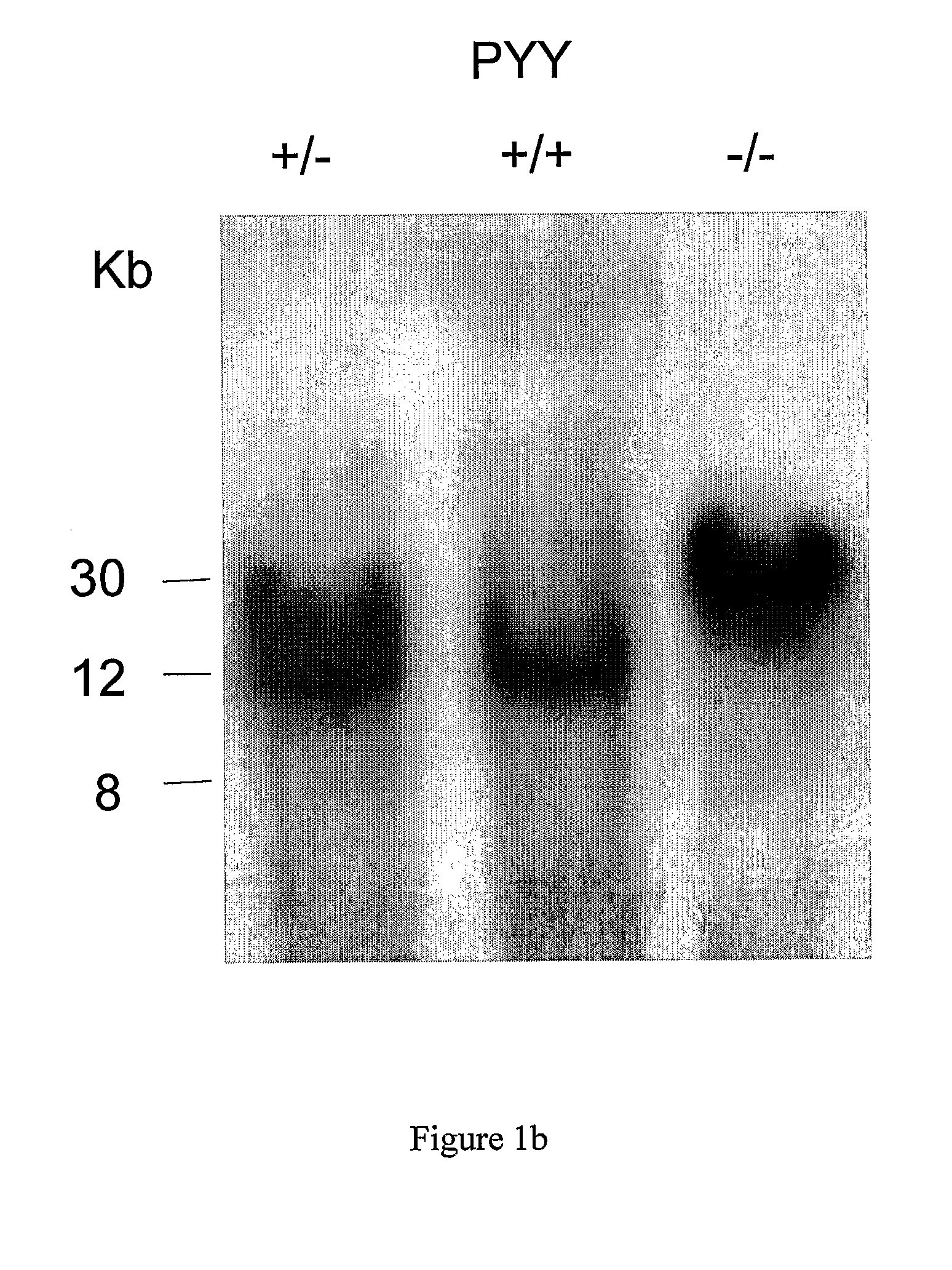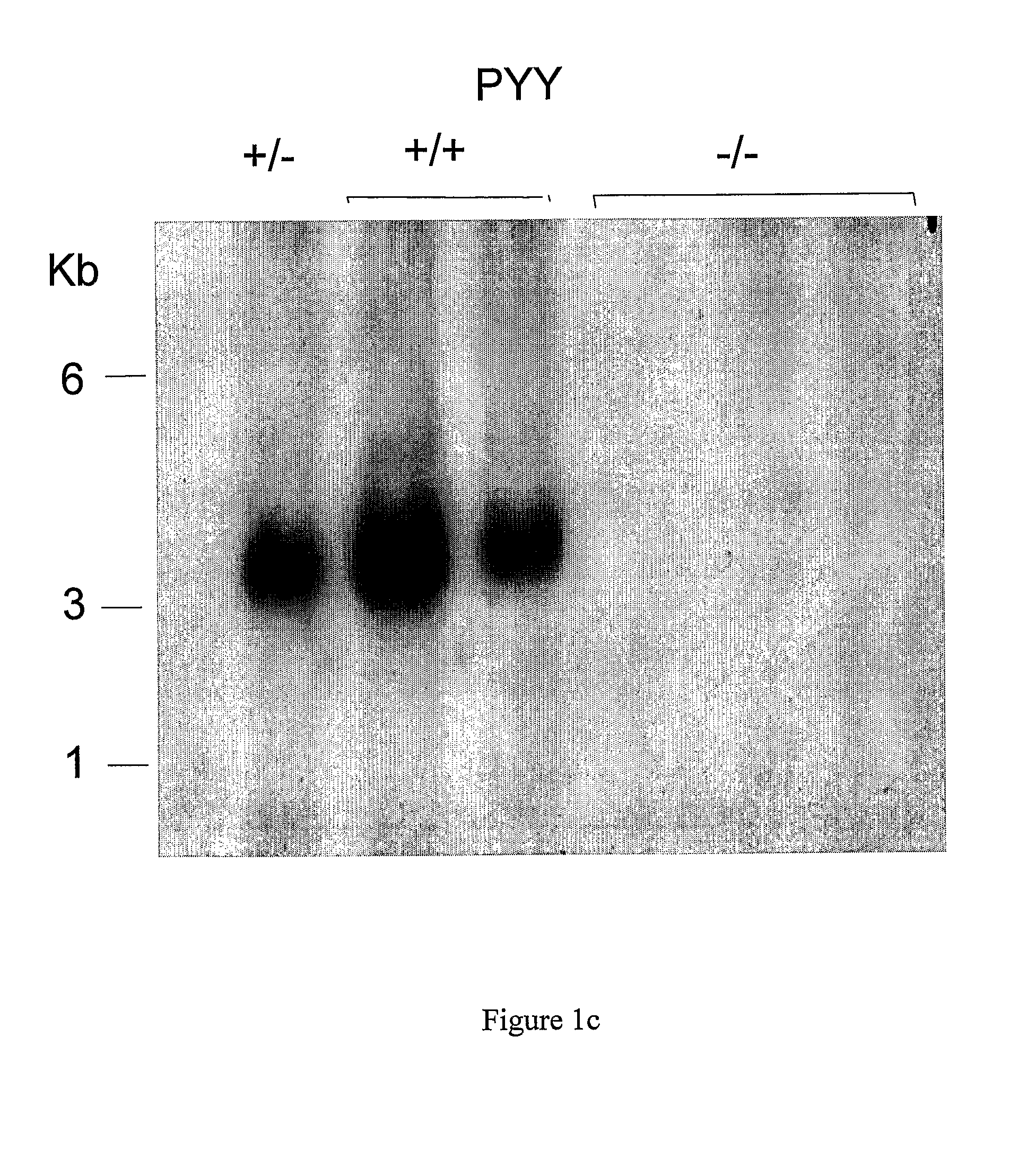Modified animal lacking functional PYY gene, monoclonal antibodies that bind PYY isoforms and uses therefor
a technology of functional pyy and monoclonal antibodies, which is applied in the field of modified animals lacking functional pyy gene, monoclonal antibodies that bind pyy isoforms and uses therefor, can solve the problems of increased body weight, increased body fat, increased fat mass and glucose intolerance, etc., and achieves increased basal levels of free fatty acids and triglycerides, increased serum insulin, and increased fasting and glucose induced levels
- Summary
- Abstract
- Description
- Claims
- Application Information
AI Technical Summary
Benefits of technology
Problems solved by technology
Method used
Image
Examples
example 1
Production of Mice having Reduced PYY Expression
PYY Targeting Vector Construction and Gene Disruption
[0497]A 130 kb mouse genomic BAC clone comprising the PYY gene was mapped and various fragments sub cloned. A 10.5 kb SpeI fragment containing 6 kb 5′-flanking sequence, the entire PYY gene and 3 kb 3′-flanking sequence was chosen for the construction of a PYY-Cre construct to target PYY disruption. The sequence immediately behind the start codon of the PYY gene starting at nucleotide 6330 continuing to the NheI restriction site at nucleotide 10377 was replaced with a cassette which allows the inducible transcription of the Cre and EGFP genes under the control of the PYY promoter. To achieve this, the reverse Tet repressor (rTetR) gene (Clontech) was fused in frame with the mouse PYY gene. This was followed by the insertion of a cassette containing the EGFP gene in opposite orientation, which had been modified to replace the start-codon replacing with a loxP sequence. Subsequently, a...
example 2
Methods for Assessing the Effects of Reduced PYY Expression
Measurement of Food Intake, Bodyweight, Temperature
[0501]All research and animal care procedures were approved by the Garvan Institute / St Vincent's Hospital Animal Experimentation Ethics Committee and were in agreement with the Australian Code of Practice for the Care and Use of Animals for Scientific Purpose. 10-20 animals per genotype originating from 3-4 different breeding pairs were group-housed under conditions of controlled temperature (22° C.) and illumination (12 hour light cycle, light onset at 7.00 am).
[0502]Mice were fed a normal chow diet ad libitum (6% calories from fat, 21% calories from protein, 71% calories from carbohydrate, 2.6 kilocalories / g, Gordon's Speciality Stock Feeds, Yanderra, NSW, Australia) or a high fat diet (46% calories from fat, 21% calories from protein, 33% calories from carbohydrate, 4.72 kilocalories / g) from 4-5 weeks of age onwards. The high fat diet, made in-house, was based on the comp...
example 3
Effects of Reducing PYY Expression on Tissue Morphology
[0516]Successful deletion of the PYY gene was confirmed by the absence of staining for PYY in the pancreas and colon of PYY− / − mice (FIG. 1d, panels (i) to (iv)). The morphology of these PYY-expressing tissues did not show any obvious changes when examined using haematoxylin and eosin staining. Moreover, the average size of the islets of Langerhans (0.022±0.004 mm2) did not significantly differ from that of wild type mice (0.035±0.008 mm2). The same is true for the number of islets per section (6.6±1.3 in PYY− / − versus 8.2±1.5 in wild type mice). Importantly, the expression of the PP gene, which is located only 8 kb downstream of the PYY gene locus, was not influenced by the removal of the PYY gene (FIG. 1d, panels (v) and (vi)), nor were the expression of glucagon (FIG. 1d, panels (vii) and (viii)) or insulin in the islets of Langerhans altered by PYY deletion.
PUM
| Property | Measurement | Unit |
|---|---|---|
| Molar density | aaaaa | aaaaa |
| Fraction | aaaaa | aaaaa |
| Fraction | aaaaa | aaaaa |
Abstract
Description
Claims
Application Information
 Login to View More
Login to View More - R&D
- Intellectual Property
- Life Sciences
- Materials
- Tech Scout
- Unparalleled Data Quality
- Higher Quality Content
- 60% Fewer Hallucinations
Browse by: Latest US Patents, China's latest patents, Technical Efficacy Thesaurus, Application Domain, Technology Topic, Popular Technical Reports.
© 2025 PatSnap. All rights reserved.Legal|Privacy policy|Modern Slavery Act Transparency Statement|Sitemap|About US| Contact US: help@patsnap.com



